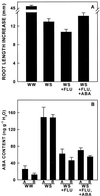Modification of expansin transcript levels in the maize primary root at low water potentials
- PMID: 11500546
- PMCID: PMC117147
- DOI: 10.1104/pp.126.4.1471
Modification of expansin transcript levels in the maize primary root at low water potentials
Abstract
We previously demonstrated that maintenance of cell elongation in the apical region of maize primary roots at low water potentials (psi(w)) was associated with an increase in expansin activity and extractable expansin protein. Here, we characterized the spatial pattern of expansin gene expression along the growing maize root and studied the effect of low psi(w) on expansin gene expression. Roots were divided into three segments: apical 0 to 5 mm, subapical 5 to 10 mm, and non-growing 10 to 20 mm. Of the five expansin genes expressed in control roots, two alpha-expansins (Exp1 and Exp5) and two beta-expansins (ExpB2 and ExpB8) are expressed specifically in the growing region, whereas expression of beta-expansin ExpB6 is shifted basipetally. After seedlings were transplanted to vermiculite with a psi(w) of -1.6 MPa, transcripts for Exp1, Exp5, and ExpB8 rapidly accumulated in the apical region of the root. These mRNA changes correlated with the maintenance of root elongation and increases in wall extensibility found previously. The beta-expansins ExpB2 and ExpB6 showed distinctive patterns of expression and responses to low psi(w,) indicative of distinctive functions. Inhibition of abscisic acid (ABA) accumulation at low psi(w) (by fluridone treatment) had no effect on expansin expression, except that ExpB2 transcript level showed a minor dependence on ABA. Gene-specific regulation of alpha- and beta-expansin mRNA pools likely contributes to growth alterations of the maize (Zea mays) root as it adapts to a low psi(w), but these changes do not appear to be mediated by changes in ABA content.
Figures





References
-
- Cho HT, Kende H. Tissue localization of expansins in deepwater rice. Plant J. 1998;15:805–812. - PubMed
Publication types
MeSH terms
Substances
LinkOut - more resources
Full Text Sources

